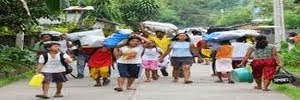
From the Website of GPH - Government of the Philippines
links: http://www.gov.ph/2015/11/05/statement-economic-planning-secretary-yolanda-rehabilitation/
Statement: Economic Planning Secretary Balisacan at the Yolanda Rehabilitation and Recovery Joint Press Briefing
During the Yolanda Rehabilitation and Recovery Joint Press Briefing, Economic Planning Secretary Arsenio Balisacan reported the progress that has been made in the two years since typhoon Yolanda hit Eastern Visayas. Currently, the government is in the medium-term phase of recovery and rehabilitation and is continuing to build infrastructure to help bolster economic activity in the region, while education and health services in the area have been restored with better climate-resilient facilities.
Statement of Economic Planning Secretary Asenio Balisacanat the Yolanda Rehabilitation and Recovery Joint Press Briefing
[Delivered at the L.S. Virata Hall, Development Academy of the Philippines on November 5, 2015]
Members of the media, colleagues in government, guests, ladies and gentlemen:
Two years after Typhoon Yolanda left Eastern Visayas a wasteland, we are witnesses to the optimism and vibrance of communities that are rebuilding their lives. Local communities of affected areas have been restored; in fact, noticeable business recovery and expansion is evident in Tacloban City and many other areas.
We are now transitioning into the medium-term phase of recovery and rehabilitation efforts after surmounting the immense challenge of providing for the immediate needs of millions of affected people.
Even for a country that had quite a lot of practice in disaster risk management, the unprecedented magnitude of the disaster that was Typhoon Yolanda and the corresponding response that it entailed meant that we were up against staggering challenges. Allow me to add that even the most advanced government in the world struggled with such a task, as the U.S. experience with Hurricane Katrina showed. International disaster experts, therefore, who have witnessed rehabilitation efforts of comparable magnitude elsewhere tend to be more generous with their assessment of Yolanda rehabilitation efforts than we allow ourselves to be.
The strategic plan Reconstruction Assistance on Yolanda (RAY) that NEDA put together with the full support of development partners, in a record 40 days after Yolanda, was born out of the recognition that although immediate humanitarian response may be expected to continue for some time, commencing recovery and reconstruction was of critical importance as reconstruction would facilitate recovery.
In the case of Yolanda recovery and rehabilitation, endeavored to start reconstruction projects as soon as possible, particularly the resettlement housing units for Yolanda survivors who have to be moved away from danger zones. Given our intention not just to rebuild but to Build Back Better, however, we found our reconstruction efforts stymied by a whole set of serious policy and implementation issues. These include policies on procurement and land acquisition and the many required permits and clearances needed to start certain projects.
Given the significant delays that these policies and procedures have caused, these policies need to be reviewed and changed, if necessary. Housing and Urban Development Coordinating Council (HUDCC) and the National Housing Authority (NHA) are here to share how we are managing these obstacles to fast-track the pace of construction of houses going forward.
As agencies began working on projects, we learned that several national laws, policies and practices have been getting in the way of resource mobilization and fund disbursement, and have been a major hindrance to project implementation. The Department of Budget and Management (DBM), Secretary Abad, can enlighten us more later about how these challenges are being addressed.
We are happy to report that we are on track in completing infrastructure projects. Majority of the roads, bridges, ports and telecommunication facilities, which are key in restoring economic activity, have already been reconstructed and even upgraded for resiliency. The Department of Public Works and Highways is here to tell us more about this.
While the social services cluster headed by the Department of Social Welfare and Development (DSWD) remains very busy to this day, we are pleased to know that education and health services have been restored, now with better facilities such as climate-resilient buildings. DSWD is here to give us a good picture of the progress that has been made in delivering social services to the Yolanda survivors.
The Department of Trade and Industry (DTI) will tell us more about how they are ensuring that the survivors, especially those in the resettlement sites away from the coasts, will have access to sources of livelihood.
As we look back to the last two years of rebuilding and improving government’s capacity to respond to natural disasters post-Yolanda, we saw that we still have quite a way to go towards the convergence that this kind of operation calls for. It is a process and we continue to work towards convergence and coordination as recovery and rehabilitation of this magnitude requires long-term commitment and support.
The first lesson from Yolanda post-disaster recovery is coordination, coordination, and coordination. Coordination must be paramount and ingrained in the consciousness of everyone long before a disaster even strikes. In the case of Yolanda rehabilitation, some implementation bottlenecks have been addressed through close coordination provided by the cluster system under the guidance of the then Presidential Assistant for Rehabilitation and Recovery now of NEDA. The lessons learned can be useful insights to the upcoming sunset review of the Philippine Disaster Risk Reduction Management Law of 2010.
As the government’s socioeconomic planning agency, NEDA is working to ensure that recovery is on track so we can achieve broader development goals set under the Philippine Development Plan.
They heart in realizing that we have since emerged as a more disaster-resilient nation. Typhoon Yolanda prompted us to institute policies that ensure macroeconomic and fiscal stability so that economic disruptions, even of this scale, are not as extensive.
We have also recently invested in science-based information systems that will alert our local governments on areas at risk. This will enable our communities to be more prepared and well-informed for natural hazards, and eventually have zero casualty at all times.
We have accomplished much over the last two years, but there is still a lot that must be done in creating the enabling environment and ensuring that governance practices make it easier to build back better, safer and faster, as the times require.
Typhoon Yolanda disrupted many lives as well as the normal workings of government. After two years of working to restore normalcy and, at the same time, attempting to raise the bar in the living conditions of Yolanda-affected communities, we now finally have the momentum we need to take our recovery and rehabilitation efforts to the next level and continue to improve our country’s disaster resilience.
GPH Website
Article links:
http://www.gov.ph/2015/11/05/statement-economic-planning-secretary-yolanda-rehabilitation/
http://www.gov.ph/2015/11/05/statement-economic-planning-secretary-yolanda-rehabilitation/
OTHER HUMAN RIGHTS PROMOTIONS WEBSITES
PROTECTION AND PROMOTION OF HUMAN RIGHTS
-----------------------------------------------------------------------------------------------
------------------------------------------------------------
-----------------------------------
























0 comments:
Post a Comment